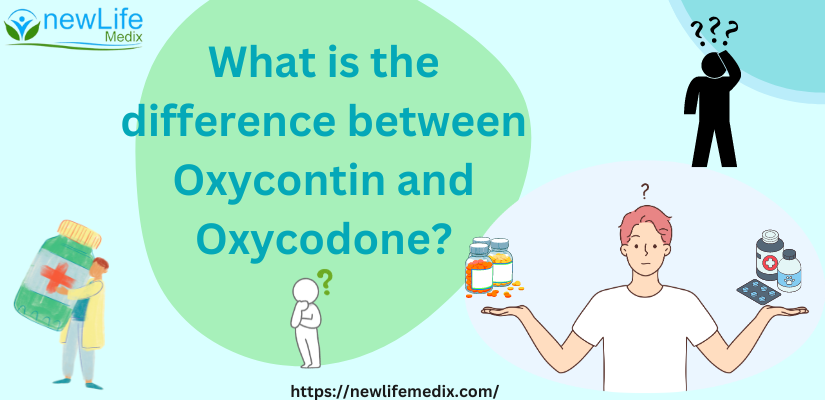Nowadays people are suffering from various pains from moderate to severe. Using a painkiller is common these days. Among lots of medicines, there are two medicines that people use very often: Oxycontin and Oxycodone. Both are pain relief drugs and almost the same working people interchange with each other, which is not good.
Here we will learn, what is the difference between Oxycontin and Oxycodone on different factors like side effects, chemical composition, and doses.
What is Oxycontin & Oxycodone?
Oxycodone and Oxycontin both belong to the same Opioid or Narcotics drugs class used for pain relief. The medicine Oxycodone is an opioid substance, that is the main chemical ingredient in several pain relief medications, including Oxycontin. Oxycodone Hydrochloride is the main active chemical substance in both of the drugs. Oxycontin is known as the time-release version of Oxycodone medicine.
They almost share the same composition, side effects, and precautions but have some minor differences. Both drugs release Dopamine that makes you feel good or even high, depending on the doses. Doctors need to monitor their patients closely, whether these medications are helping or not or the patients getting addicted to them.
What are the uses of Oxycontin and Oxycodone?
Uses of Oxycontin:
This medicine is used to treat moderate to severe pain. By changing the response of pain signals from the body to the brain and nervous system. It also helps in reducing chronic pain, and anxiety. and is typically utilized in knee replacement or a traumatic event (fracture Bone).
Uses of Oxycodone:
Oxycodone works similarly to Oxycontin and is used to treat moderate to severe pain and control the response of the pain signal coming from the body part to the nervous system and the brain there are two forms immediate-release and extended-release oxycodone.it is utilized after surgery or injury.
The side effects of Oxycodone and Oxycontin?
Side Effects of Oxycodone:
The rate of side effects of oxycodone is 1 or 2 in 100 people. The common side effects are Constipation, Feeling of being sick stomach discomfort, Itchiness, or rash.
Side Effects of Oxycontin:
As Oxycontin is the time-release version of Oxycodone, they almost share the same side effects.
Below are some common side effects that are caused by both drugs.
Immediate effects that occur for those who use the drugs are :
- Feelings of euphoria
- Feelings of relaxation
- Marked reduction in the subjective experience of pain
- Marked reductions in anxiety
- Increased sedation
Side effects depending on Individual Body Type:
- Gastrointestinal issues (like Nausea, Stomach cramps, Vomiting, and Constipation)
- Drowsiness
- Flushing
- Sweating
- Dry mouth
- Loss of appetite
- Weakness
- Headache
- Dizziness
- Allergic reaction (Hives, Itching, Rash, and Swelling of the Face, Throat, and Tongue, Lips, or Extremities)
- Respiratory Issues
- Postural Issues
- Cardiovascular issues like changes in Heartbeat or Blood pressure
- Seizures, in rare cases
This is not the all possible side effect of these drugs if you find out something out of the list then contact your doctor as soon as possible.
Effective Doses of Oxycodone & Oxycontin:
The following formulations are found in Oxycodone:
- Immediate-release capsules
- It is available in the following strengths
- Immediate-release tablets
- Immediate-release solution
- It is available in the following strengths
- 5mg/5ml, 100mg/5ml
- It is available in the following strengths
The following formulations are found in Oxycontin:
- Controlled-release tablets
- It is available in the following strengths
- 10mg, 15mg, 20mg, 30mg, 40mg, 60mg, 80mg
- It is available in the following strengths
The gap between the medicine intake of Oxycodone is 6 hours and Oxycontin is 12 hours and should not be taken with other opioids or alcohol substances.
The best way to store Oxycodone and Oxycontin
Oxycodone is stored at a temperature between 68℉ and 77℉ (20℃ and 25℃).
Oxycontin stores at a temperature between 68℉ and 77℉ (20℃ and 25℃).
All medication must be kept away from pets and small children, It might be lethal for them.
Interaction of Oxycodone and Oxycontin
Both drugs almost have the same composition and chemical substance. so they have the same interaction, such as:
- Antibiotics(Clarithromycin and erythromycin)
- Antidepressants(Tricyclic antidepressants, Monoamine oxidase inhibitors, or SSRIs)
- Antifungal agents(Itraconazole and Ketoconazole)
- Anticonvulsants(Carbamazepine, Phenytoin, Phenobarbital, or Primidone)
- Antipsychotics(Butyrophenones, Phenothiazines, or Thioxanthenes)
- Atypical antipsychotics( Olanzapine, Quetiapine, Ziprasidone)
- Any medication that causes drowsiness like Benzodiazepines(Diazepam, lorazepam)
- Buprenorphine
- Migraine medication
- Medication that inhibits Hepatic enzymes (ex: CYP3A4 or CYP2D6 or induces CYP3A4)
- Alcohol
- Central Nervous System Depressants
This is not all possible interaction of these drugs there are many more interactions found, if you have any other problem from this list then must contact your doctor and take proper medication, that benefits you.
Summary:
In this blog, we have learned about what is the difference between Oxycodone and Oxycontin, major side effects, uses, and doses. Both Oxycodone and Oxycontin are of the same drug class which helps in controlling pain. Although both have almost similar work and a little bit of difference in them. The doses between these two drugs totally depend on the conditions of your treatment and the amount of pain you are suffering from. Taking anything excess is harmful so don’t fully depend on these painkillers, let the body heal on its own.
Read More:
How Long Does Oxycodone Stay in Urine?

